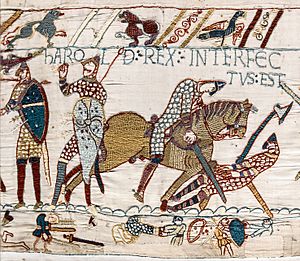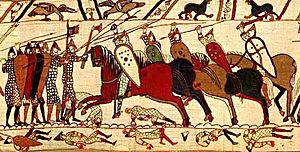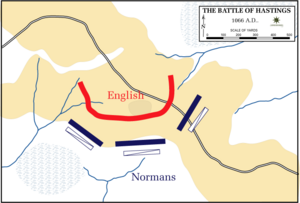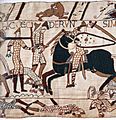Battle of Hastings facts for kids
Quick facts for kids Battle of Hastings |
|||||||
|---|---|---|---|---|---|---|---|
| Part of the Norman conquest of England | |||||||
 Harold Rex Interfectus Est: "King Harold is killed." Scene from the Bayeux Tapestry depicting the Battle of Hastings and the death of Harold |
|||||||
|
|||||||
| Belligerents | |||||||
| Normans | Anglo-Saxon England | ||||||
| Commanders and leaders | |||||||
| William of Normandy Alan the Red William FitzOsbern Eustace II, Count of Boulogne |
Harold Godwinson † Gyrth Godwinson † Leofwine Godwinson † |
||||||
| Strength | |||||||
| Unknown, estimates range from 7,000 to 12,000 | Unknown, estimates range from 5,000 to 13,000 | ||||||

The Battle of Hastings happened on October 14, 1066. It was a fight between the English and an army from Normandy. Normandy is a region in France.
The battle lasted only one day. It ended with the death of the English king. The Normans won a big victory. William, the Duke of Normandy, became King William I of England ten weeks later. This event, called the Norman Conquest, changed England's history forever.
Contents
Why the Battle Happened
In 1002, the King of England, Ethelred, married Emma of France. She was the sister of the Duke of Normandy. This marriage created a link between England and Normandy.
Years later, in 1016, a Viking king named Canute took over England. He married Queen Emma, who was King Ethelred's widow. Emma's two sons from her first marriage, including Edward the Confessor, went to Normandy for safety. Edward stayed there for many years. His cousin, Duke William, protected him. William later became known as William the Conqueror.
Who Would Be King?
Edward became King of England in 1042. He had no children. In 1052, King Edward said that William would be his heir. This meant William would be the next king.
In 1065, Harold Godwinson, a powerful English earl, visited Normandy. While there, he promised Duke William that he would support William as the next king of England.
When King Edward died on January 5, 1066, three men believed they should be the next king:
- William, the Duke of Normandy, because King Edward had promised him the throne.
- Harold Godwinson, the Earl of Wessex, who was a powerful English noble.
- King Harald Hardrada of Norway, who wanted a Viking king to rule England again.
The day after King Edward's death, Harold Godwinson was crowned king of England. He did not keep his promise to William. Some stories say King Edward changed his mind on his deathbed. He supposedly promised the throne to Harold. But Harold was not from the royal family. He had no legal right to be king.
Getting Ready for Battle
When Duke William heard that Harold Godwinson was crowned king, he acted fast. He called his most important men together. William planned to gather a huge army from all over France. He was rich and powerful, so he could start a big military plan against Harold.
William's Preparations
William's first job was to build many ships. These ships would carry his army across the English Channel. Then, he started gathering soldiers. He got help from Brittany, France, and Flanders. He also hired soldiers from other parts of Europe. William even got support from the pope, who gave him a special banner for the battle.
King Harald Hardrada of Norway also heard about King Edward's death. He and Duke William were planning their own invasions of England at the same time. King Harold Godwinson of England knew both would come for his throne. He got his army ready for war.
Harald of Norway reached England before William. King Harold Godwinson marched his army north. He defeated the Norwegian King Harald at Stamford Bridge.
William Crosses the Channel
William had about 1,000 ships for his invasion. They left Normandy on the night of September 27, 1066. The winds were good. William's ship, the Mora, led the fleet. It was a gift from his wife, Matilda. They landed at Pevensey the next morning.
As soon as William landed, he heard about King Harold's victory over the Norwegians. This meant King Harold had to move his tired army south quickly. Harold rested in London for a few days. Then he took his army south to meet William and his French forces.
The Battle of Hastings
King Harold Godwinson had more soldiers. But they were tired from their long march from London. Harold's army took a strong position on a hill north of Hastings. This hill was called Senlac Hill.
They saw the Norman army marching up the valley towards them. William lined up his soldiers at the bottom of the hill. The English formed a strong "shield wall" at the top.
First Attacks
William sent his archers halfway up the hill to shoot at the English. He sent his mounted knights (soldiers on horses) to the sides. They looked for weak spots in the English line.
At first, William's knights tried to break the shield wall. They used the power of their horses. But this plan did not work. They were attacking uphill and could not go fast enough. Harold's front line stood firm. They fought off every attack.
William's Trick
At one point, William's army started to fall back. Rumors spread that William was dead. Duke William took off his helmet. This showed his men he was still alive.
William then saw many of Harold's men following his knights down the hill. He used a trick he knew. He suddenly turned and charged the English foot soldiers. They had no chance against knights on horses. This tactic worked at least two more times. It made Harold's shield wall weaker.
The Final Push
Next, William tried something new. Before, his knights and archers attacked separately. Now, he used them together. His archers had not broken the shield wall. So, he told them to shoot high into the air. The arrows came down on top of the English soldiers.
This might be how King Harold was killed. An arrow may have hit him in the eye. The shield wall finally broke. The Normans then overwhelmed the English. By nightfall, most of the English were dead or being hunted down. William called his men back. They camped on the battlefield for the night.
After the Battle
The battle was won. But smaller English armies still existed. They had not joined King Harold at Hastings. They had lost their king but were trying to regroup.
William rested his army for five days. Then he marched towards London. He captured or destroyed several towns along the way. When William reached London, the English resisted for a short time. But in the end, they gave up.
The Battle of Hastings was a huge turning point in English history. William had a strong claim to the throne. He was able to use force to make it happen. On Christmas Day in 1066, William was crowned King of England.
The battle is shown in a series of pictures called the Bayeux Tapestry. William's victory at Hastings gave him his famous nickname: "William the Conqueror."
Interesting Facts About the Battle of Hastings
- The battle happened about seven miles from Hastings. The town there is now named "Battle."
- The first person killed in the battle was William's jester, Taillefer.
- The battle lasted from 9:00 a.m. until dusk.
- The Normans used a trick called "feigned flight." They pretended to retreat. This made the English chase them. Then the Normans turned and attacked the spread-out English.
- William kept his promise to build an Abbey after he won the battle.
- William spoke only French. After he became king, he made French the language of the court. This added many French words to the English language.
Images for kids
-
The location of the Battle of Stamford Bridge
-
William built a castle within old Roman ruins after landing at Pevensey.
-
Norman knights and archers at the Battle of Hastings, from the Bayeux Tapestry
-
View of the battlefield looking towards Senlac Hill
-
Stone marking the spot where Harold died at Battle Abbey.
-
A Battle of Hastings reenactment in front of Battle Abbey.
See also
 In Spanish: Batalla de Hastings para niños
In Spanish: Batalla de Hastings para niños












